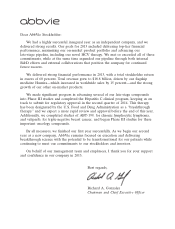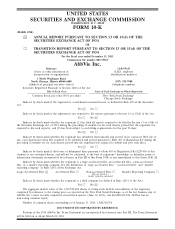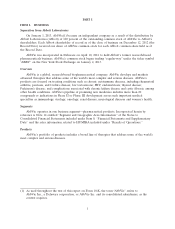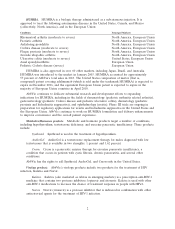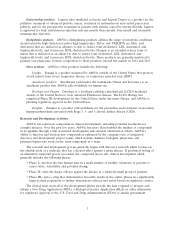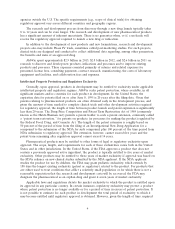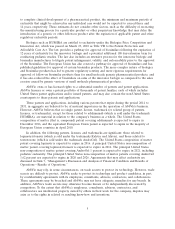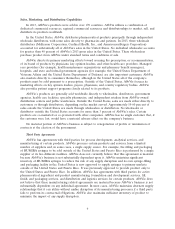AbbVie 2013 Annual Report Download - page 9
Download and view the complete annual report
Please find page 9 of the 2013 AbbVie annual report below. You can navigate through the pages in the report by either clicking on the pages listed below, or by using the keyword search tool below to find specific information within the annual report.to complete clinical development of a pharmaceutical product, the minimum and maximum periods of
exclusivity that might be achieved in any individual case would not be expected to exceed three and
14 years, respectively. These estimates do not consider other factors, such as the difficulty of recreating
the manufacturing process for a particular product or other proprietary knowledge that may delay the
introduction of a generic or other follow-on product after the expiration of applicable patent and other
regulatory exclusivity periods.
Biologics such as HUMIRA are entitled to exclusivity under the Biologics Price Competition and
Innovation Act, which was passed on March 23, 2010 as Title VII to the Patient Protection and
Affordable Care Act. The law provides a pathway for approval of biosimilars following the expiration of
12 years of exclusivity for the innovator biologic and a potential additional 180 day-extension term for
conducting pediatric studies. The law also includes an extensive process for the innovator biologic and
biosimilar manufacturer to litigate patent infringement, validity, and enforceability prior to the approval
of the biosimilar. The European Union has also created a pathway for approval of biosimilars and has
published guidelines for approval of certain biosimilar products. The more complex nature of biologics
and biosimilar products has led to greater regulatory scrutiny and more rigorous requirements for
approval of follow-on biosimilar products than for small molecule generic pharmaceutical products, and
it has also reduced the effect of biosimilars on sales of the innovator biologic as compared to the sales
erosion caused by generic versions of small molecule pharmaceutical products.
AbbVie owns or has licensed rights to a substantial number of patents and patent applications.
AbbVie licenses or owns a patent portfolio of thousands of patent families, each of which includes
United States patent applications and/or issued patents, and may also contain the non-United States
counterparts to these patents and applications.
These patents and applications, including various patents that expire during the period 2014 to
2031, in aggregate are believed to be of material importance in the operation of AbbVie’s business.
However, AbbVie believes that no single patent, license, trademark (or related group of patents,
licenses, or trademarks), except for those related to adalimumab (which is sold under the trademark
HUMIRA), are material in relation to the company’s business as a whole. The United States
composition of matter (that is, compound) patent covering adalimumab is expected to expire in
December 2016, and the equivalent European Union patent is expected to expire in the majority of
European Union countries in April 2018.
In addition, the following patents, licenses, and trademarks are significant: those related to
lopinavir/ritonavir (which is sold under the trademarks Kaletra and Aluvia), and those related to
testosterone (which is sold under the trademark AndroGel). The United States composition of matter
patent covering lopinavir is expected to expire in 2016. A principal United States non-composition of
matter patent covering lopinavir/ritonavir is expected to expire in 2016. The principal United States
non-composition of matter patent covering AndroGel 1 percent is expected to expire in 2021, including
pediatric exclusivity. The principal United States non-composition of matter patents covering AndroGel
1.62 percent are expected to expire in 2020 and 2026. Agreements that may affect exclusivity are
discussed in Item 7, ‘‘Management’s Discussion and Analysis of Financial Condition and Results of
Operations—Results of Operations.’’
AbbVie may rely, in some circumstances, on trade secrets to protect its technology. However, trade
secrets are difficult to protect. AbbVie seeks to protect its technology and product candidates, in part,
by confidentiality agreements with its employees, consultants, advisors, contractors, and collaborators.
These agreements may be breached and AbbVie may not have adequate remedies for any breach. In
addition, AbbVie’s trade secrets may otherwise become known or be independently discovered by
competitors. To the extent that AbbVie’s employees, consultants, advisors, contractors, and
collaborators use intellectual property owned by others in their work for the company, disputes may
arise as to the rights in related or resulting know-how and inventions.
5



